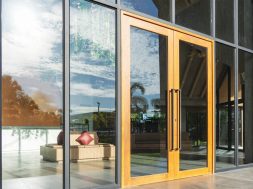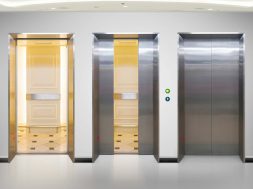Fenestration trends and market standards in flux

Through the windows of innovation, we witness the evolution of fenestration that meets sustainability, and market standards which are framing a future design excellence.
Fenestrations, those carefully crafted openings in a building’s envelope, have far-reaching implications beyond mere architectural allure. The Indian façade and fenestration market is valued at US$ 2.8bn in 2023 and is expected to reach US$ 5.4bn by 2032.
Against the backdrop of a burgeoning construction sector, the Indian window and façade industry are witnessing remarkable growth. According to a report by Research and Markets, the Indian fenestration market is poised to grow at a robust CAGR of 7.2 percent from 2021 to 2026, reaching a formidable market size of USD 7.8 billion by 2026. This surge can be attributed to escalating urbanisation, increasing disposable income, and governmental emphasis on affordable housing initiatives. Mario Schmidt, Managing Director of Lingel, affirms “Embarking on a nearly two-decade-long journey in India, Lingel thrives on growth and innovation, solidifying our position as a fenestration solutions market leader. With a commitment to customer satisfaction, our diverse options and earned trust, reflected in 60 to 70 percent referrals, have defined a highly successful 17-year journey in contributing to landmark projects.” Babak Golriz, Head of Expanding Markets, Africa, Middle East, Asia & Australasia, aluplast GmbH recently stated, “India is a key market for us and is at the forefront of our ambitions in Asia. The investments in the Indian affiliate presents a huge opportunity to harness technological advancements and push the boundaries of innovation to create products that are futuristic, yet versatile and regionally rooted. These additional investments will help us in ramping up our operations to meet the growing demands and expectations in India and Asian markets”
Energy efficiency imperative
The Bureau of Energy Efficiency (BEE) underscores the significant role windows play in a building’s energy dynamics, contributing to approximately 30 percent of heat gain or loss. In response, there’s a surge in demand for energy-efficient windows and facades. Studies show that adopting energy-efficient glazing systems can translate into savings of up to 20 percent in cooling and heating costs. This burgeoning trend has spurred the integration of advanced technologies and materials to enhance thermal performance and curb energy consumption.
Fenestration, covering windows, doors, and skylights, plays a crucial role in energy conservation. Well-designed fenestration enhances natural lighting, regulates heat transfer, and improves insulation, contributing to overall building energy efficiency. “Innovative technologies in energy-efficient windows include low-E coatings, double or triple-pane insulated glass units, specialised coatings for pre-existing buildings, smart windows with dynamic tinting, and frames made from thermally broken profiles. These features collectively contribute to improved energy efficiency by reducing the need for heating or cooling, optimising natural light, and minimising heat gain or loss.” Upendra Walinjkar, Founder & Principal Consultant of ALUVISION Facade Solutions.
While discussing challenges Akanksha Gupta, Partner at Vijay Gupta Architects, states “In today’s construction landscape, we face challenges that demand innovative solutions in building envelopes and fenestration.” With the pressing need for faster construction due to economic pressures, architects are adapting by choosing labour-efficient materials and assembly-friendly methods, streamlining the process. Designing for high-rise buildings involves addressing challenges like wind exposure and efficient maintenance. Exploring innovations such as self-cleaning materials holds the potential to tackle maintenance issues in the realm of high-rise structures.
Design trends driving sustainability
Smart Glazing Technologies: The advent of dynamic glass, exemplified by View Inc.’s electrochromic glass solutions, allows automatic adjustments for light and heat control. This not only minimises reliance on artificial lighting and HVAC systems but also ensures energy efficiency without compromising on natural light.
Thermal break frames: The choice of framing materials is pivotal, and thermal break frames have gained prominence. Andersen Windows, with its Fibrex® composite frames, exemplifies the integration of materials resisting heat transfer, creating a barrier against thermal bridging and energy loss.
Passive design principles: Maximising natural elements for heating, cooling, and lighting is integral to fenestration design. Thoughtful placement, as seen in Frank Lloyd Wright’s Fallingwater house, optimises energy efficiency through effective cross-ventilation and solar heat gain control.
High-performance glazing: Pella Windows and Doors lead the way with Advanced Low-E insulating glass, reflecting heat back into the room during winter and keeping it out in summer, ensuring year-round energy efficiency.
Integration of Renewable Energy: The marriage of fenestration with renewable energy is exemplified by SolarGaps, where smart blinds equipped with solar panels not only provide shade but also convert sunlight into usable energy, marking a significant step towards sustainable living.
Innovative Fenestration Technologies
Transparent to opaque glass: Evolving technology is bringing windows that transition from clear to opaque with the touch of a button. Although still in early development, this innovation has the potential to reduce cooling costs and provide built-in privacy.
Solar panel windows: While in early stages, emerging solar power technology aims to make windows generate electricity while maintaining transparency. Current efficiency rates are modest, but the potential for sustainable energy production is promising.
Smart locking systems: With connectivity via mobile and WiFi, systems like Smart Ready offer enhanced security for windows and doors, notifying homeowners of lock status and potential tampering, contributing to overall safety.
Designing for sustainability: The quest for sustainability extends beyond fenestration design to broader considerations in construction. Façades, acting as the primary barrier between interior and exterior, play a pivotal role in optimising thermal performance. From insulation materials to passive design strategies and active sustainable technologies like photovoltaic panels, the façade emerges as a critical player in creating environmentally responsible buildings.
Environment-friendly materials: An ongoing shift towards eco-friendly materials within the Architecture, Engineering, and Construction (AEC) industry is gaining momentum. Manufacturers are increasingly utilising biodegradable, recyclable, or renewable materials for fenestration systems. Aluminium and glass, prevalent in fenestration systems, are prime examples with excellent recyclable properties.
As we witness the fenestration landscape evolve, the intersection of aesthetics and sustainability emerges as a defining feature. In this dynamic arena, innovation paves the way for structures that not only captivate the eye but also stand as beacons of energy-efficient, sustainable living.
19
Cookie Consent
We use cookies to personalize your experience. By continuing to visit this website you agree to our Terms & Conditions, Privacy Policy and Cookie Policy.










